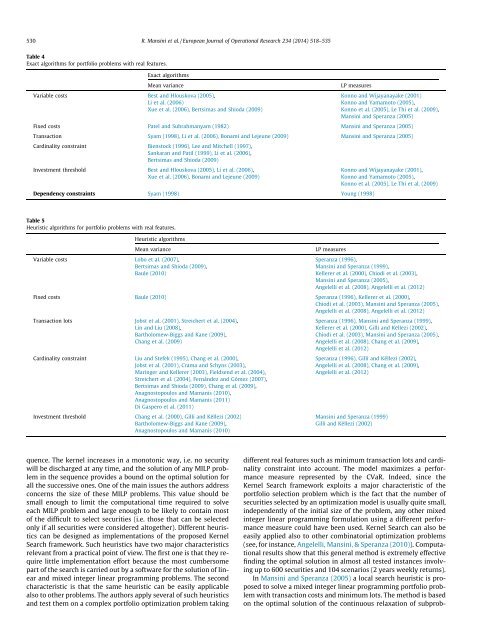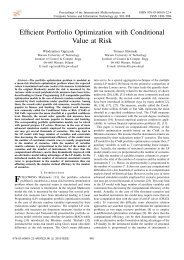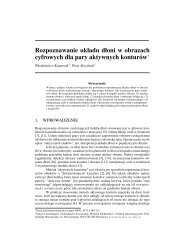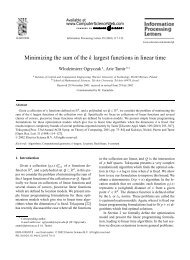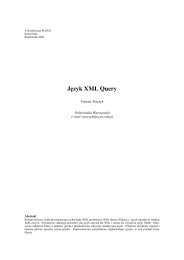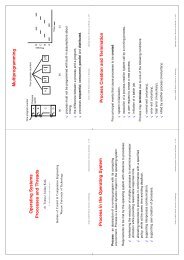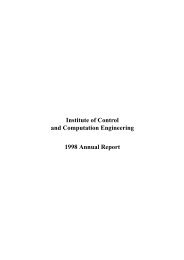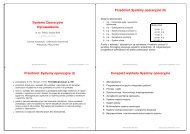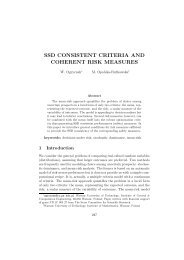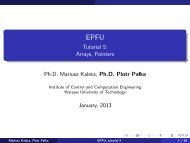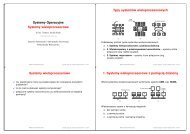Twenty Years of Linear Programming Based Portfolio Optimization
Twenty Years of Linear Programming Based Portfolio Optimization
Twenty Years of Linear Programming Based Portfolio Optimization
You also want an ePaper? Increase the reach of your titles
YUMPU automatically turns print PDFs into web optimized ePapers that Google loves.
530 R. Mansini et al. / European Journal <strong>of</strong> Operational Research 234 (2014) 518–535<br />
Table 4<br />
Exact algorithms for portfolio problems with real features.<br />
Exact algorithms<br />
Mean variance<br />
LP measures<br />
Variable costs Best and Hlouskova (2005), Konno and Wijayanayake (2001)<br />
Li et al. (2006) Konno and Yamamoto (2005),<br />
Xue et al. (2006), Bertsimas and Shioda (2009) Konno et al. (2005), Le Thi et al. (2009),<br />
Mansini and Speranza (2005)<br />
Fixed costs Patel and Subrahmanyam (1982) Mansini and Speranza (2005)<br />
Transaction Syam (1998), Li et al. (2006), Bonami and Lejeune (2009) Mansini and Speranza (2005)<br />
Cardinality constraint Bienstock (1996), Lee and Mitchell (1997),<br />
Sankaran and Patil (1999), Li et al. (2006),<br />
Bertsimas and Shioda (2009)<br />
Investment threshold Best and Hlouskova (2005), Li et al. (2006), Konno and Wijayanayake (2001),<br />
Xue et al. (2006), Bonami and Lejeune (2009) Konno and Yamamoto (2005),<br />
Konno et al. (2005), Le Thi et al. (2009)<br />
Dependency constraints Syam (1998) Young (1998)<br />
Table 5<br />
Heuristic algorithms for portfolio problems with real features.<br />
Heuristic algorithms<br />
Mean variance<br />
LP measures<br />
Variable costs Lobo et al. (2007), Speranza (1996),<br />
Bertsimas and Shioda (2009), Mansini and Speranza (1999),<br />
Baule (2010) Kellerer et al. (2000), Chiodi et al. (2003),<br />
Mansini and Speranza (2005),<br />
Angelelli et al. (2008), Angelelli et al. (2012)<br />
Fixed costs Baule (2010) Speranza (1996), Kellerer et al. (2000),<br />
Chiodi et al. (2003), Mansini and Speranza (2005),<br />
Angelelli et al. (2008), Angelelli et al. (2012)<br />
Transaction lots Jobst et al. (2001), Streichert et al. (2004), Speranza (1996), Mansini and Speranza (1999),<br />
Lin and Liu (2008), Kellerer et al. (2000), Gilli and Këllezi (2002),<br />
Bartholomew-Biggs and Kane (2009), Chiodi et al. (2003), Mansini and Speranza (2005),<br />
Chang et al. (2009) Angelelli et al. (2008), Chang et al. (2009),<br />
Angelelli et al. (2012)<br />
Cardinality constraint Liu and Stefek (1995), Chang et al. (2000), Speranza (1996), Gilli and Këllezi (2002),<br />
Jobst et al. (2001), Crama and Schyns (2003), Angelelli et al. (2008), Chang et al. (2009),<br />
Maringer and Kellerer (2003), Fieldsend et al. (2004), Angelelli et al. (2012)<br />
Streichert et al. (2004), Fernández and Gómez (2007),<br />
Bertsimas and Shioda (2009), Chang et al. (2009),<br />
Anagnostopoulos and Mamanis (2010),<br />
Anagnostopoulos and Mamanis (2011)<br />
Di Gaspero et al. (2011)<br />
Investment threshold Chang et al. (2000), Gilli and Këllezi (2002) Mansini and Speranza (1999)<br />
Bartholomew-Biggs and Kane (2009), Gilli and Këllezi (2002)<br />
Anagnostopoulos and Mamanis (2010)<br />
quence. The kernel increases in a monotonic way, i.e. no security<br />
will be discharged at any time, and the solution <strong>of</strong> any MILP problem<br />
in the sequence provides a bound on the optimal solution for<br />
all the successive ones. One <strong>of</strong> the main issues the authors address<br />
concerns the size <strong>of</strong> these MILP problems. This value should be<br />
small enough to limit the computational time required to solve<br />
each MILP problem and large enough to be likely to contain most<br />
<strong>of</strong> the difficult to select securities (i.e. those that can be selected<br />
only if all securities were considered altogether). Different heuristics<br />
can be designed as implementations <strong>of</strong> the proposed Kernel<br />
Search framework. Such heuristics have two major characteristics<br />
relevant from a practical point <strong>of</strong> view. The first one is that they require<br />
little implementation effort because the most cumbersome<br />
part <strong>of</strong> the search is carried out by a s<strong>of</strong>tware for the solution <strong>of</strong> linear<br />
and mixed integer linear programming problems. The second<br />
characteristic is that the same heuristic can be easily applicable<br />
also to other problems. The authors apply several <strong>of</strong> such heuristics<br />
and test them on a complex portfolio optimization problem taking<br />
different real features such as minimum transaction lots and cardinality<br />
constraint into account. The model maximizes a performance<br />
measure represented by the CVaR. Indeed, since the<br />
Kernel Search framework exploits a major characteristic <strong>of</strong> the<br />
portfolio selection problem which is the fact that the number <strong>of</strong><br />
securities selected by an optimization model is usually quite small,<br />
independently <strong>of</strong> the initial size <strong>of</strong> the problem, any other mixed<br />
integer linear programming formulation using a different performance<br />
measure could have been used. Kernel Search can also be<br />
easily applied also to other combinatorial optimization problems<br />
(see, for instance, Angelelli, Mansini, & Speranza (2010)). Computational<br />
results show that this general method is extremely effective<br />
finding the optimal solution in almost all tested instances involving<br />
up to 600 securities and 104 scenarios (2 years weekly returns).<br />
In Mansini and Speranza (2005) a local search heuristic is proposed<br />
to solve a mixed integer linear programming portfolio problem<br />
with transaction costs and minimum lots. The method is based<br />
on the optimal solution <strong>of</strong> the continuous relaxation <strong>of</strong> subprob-


